Heart of Dryness: The Rule of Water for Botswana’s Bushmen
In the fourth installment of Heart of Dryness, author James G. Workman explains the historic transformation of water across Botswana’s Kalahari. Workman continues to follow Qoroxloo, showing how the Bushmen have adapted to water scarcity and fluctuating hydrology.
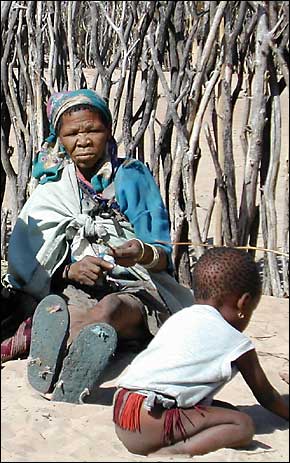
By James G. Workman
Special to Circle of Blue
Ancient scriptures and modern westerns warn us of risks inherent to the desert. The Latin root of desert was originally equated with wilderness, a people-abandoned place of spiritual desolation. Out there in the remote desert wilds lay a lawless existence, a danger zone lurking beyond the boundaries of decency, a land ruled by turmoil and existential doubt. In the desert Moses’s people wandered in anguished confusion, and even Jesus wavered. Out there, “chaos was the law of nature,” affirmed Henry James. “Order was the dream of man.”
From ancient Rome to modern nation-states, civilization imposed order on wild nature, lest nature impose its chaos on us. As Charles Darwin prepared his Origin of Species, what Victorians feared most was that the amoral blade of natural selection might lay waste to the existing benevolent theological order:
Who trusted God was love indeed
And love Creation’s final law
Tho’ Nature, red in tooth and claw
With ravine, shriek’d against his creed
Nowhere did that law of tooth and claw appear to menace more than in Africa. Old maps filled blank spots with fierce beasts and savage humans, and even in the 20th Century, National Geographic and Animal Planet documentaries filled suburban living rooms the Dark Continent’s rat-eating plants, snake-eating frogs, bird-eating spiders, man-eating lions and monkey-eating humans. News reports suggested that Africa’s indigenous tribes lacked any overriding laws to guide their passions, resulting in unbridled lusts, child soldiers, superstitious cannibalism, and genocide. Yet a closer look at the dynamics underlying Africa’s wild deserts revealed less random chaos than structured order, less anarchy than a natural, and even rather beautiful, dictatorship.
Indeed, as science revealed the intricate mechanisms of natural selection, hardened Darwinian atheists suspected an almost religious Common Destiny at work on Earth. The elemental catalyst behind this higher purpose was not oxygen, sunlight, fire or soil; none of these were essential to maintain all life forms. The force that governed existence in dry lands was the relentless quest for water.
Organisms evolved through the desert’s unforgiving but impartial justice. Moisture-capturing and retaining species won eternity: reproduction. Failures met the end of birth: extinction. Out of this arid dictatorship emerged a profusion of intricate adaptation by all plant and animal species, including Homo sapiens.
Adaptation didn’t appear spontaneously, out of nowhere. It evolved literally at a glacial pace, in response to incrementally drier conditions. As Ice Ages advanced and receded from Polar Regions, climate gradually transformed the Kalahari.
The Bushmen’s Reserve wasn’t always so dry. Satellite images reveal the shoreline of what was once a vast, ancient body of fresh water, when Botswana’s Kalahari heartland had once been submerged, flooded by as many as three great rivers. Two million years ago it held a 50-meter-deep ‘superlake,’ with its own weather system, that may have resembled North America’s own, now gradually shrinking, Great Lakes.
What happened to all that water? First, earthquakes. As an extension of the Rift Valley, Botswana’s northern edge has always been tectonically active. A million years ago geological plates collided and gradually lifted up southern Africa’s central plateau. The effect diverted the rivers off to the Zambezi, the Limpopo, the Orange; the Okavango backed up onto itself and became a stagnant swamp.
Heat followed the plate tectonics, when a few degrees rise in temperature lifted off 96 percent of the region’s surface water. Elsewhere in tropical Africa, a half dozen millennia of evaporation converted a 1,000-foot-deep lake into a bone-dry crater today, while the 154,000 square mile Lake Chad—a body of water larger than the Caspian Sea—contracted exponentially to less than 200 square miles today. Millions farm its receding edges, migrating inward into the vortex as the mudflats turn to dust.
In the Kalahari, the earliest Bushmen ancestors might have encountered a body of water 30 meters deep, but by 10,000 years ago nothing remained but the giant Makgadikgadi Pans. These flat, seasonal pans were phenomenal. For a few months, after brief thundershowers, short grass in the pans attracted innumerable zebra and blue wildebeest, but most of the year they spread out as hard and flat as concrete.
As lakes evaporated into pans, their flowing sources also shrank. Roiling rivers diminished to feeder streams, streams became dry beds, and beds eventually sank down into depressed fossil creeks. Bushmen, who knew these fossil creeks intimately, explained how their meanders were carved out as one of their gods, Ga’mama, dragged his snake-bit leg across the sands in search of waters to drink.
In a less mythical way, thirst also sculpted the Kalahari’s living inhabitants. “Most plants and animals survive in the desert” explained Africa’s foremost desert ecologists, “because they do not live in the desert.” Natural selection equipped organisms with the tools and behavioral memes, or inherited wisdom, that enabled them to tolerate, avoid or escape the most extreme and unforgiving conditions of heat and water scarcity in the desert. Plants and animals retreated to become dormant and inactive during the worst hours, days, seasons or years in the desert. Alternatively they migrated, trekking with the seasonal and annual variations over long distances. Under the arid order these physical and behavioral traits coevolved, first in plants, insects, and increasingly complex vertebrates; then in our own species.
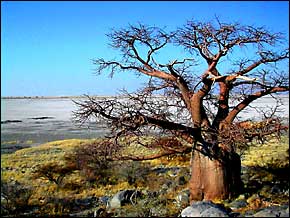
Drought’s dictatorship shapes Kalahari vegetation. The Camelthorn acacia sinks taproots to extract every precious drop from pores of deep sand. The Baobab’s spongy bark is saturated with water to last through protracted droughts. The Kalahari ‘rain tree’ attracts insects that scatter down moisture on cloudless days.
Grasses and shrubs chase down water in slow motion. Vines, creepers, tuberous species lie dormant in wait for years waiting to reach out, and pounce on any microscopic drops that meander past. Lichen snag water vapor from the air; ground-hugging leaves pin down night moisture; roots hunt seep lines for water pockets between grains of sand deep beneath the surface. To reduce drying, many plants carried out photosynthesis in the stems, or dropped moisture-losing leaves during the longest, driest, and hottest days of the year. All these plants clung fiercely to whatever water they caught. Some lie on wax, compete for precious shade, follow the solar arc to minimize stem exposure, or stop breathing until nighttime. To reduce moisture loss, trees shrink leaf size, fold leaves during the day, or drop them during the hot season. Certain Kalahari leaf patterns even funnel precious drops of rain inward and down to the bulb or tuber root structure beneath the ground.
The same ruthless order governs desert insects. They absorb moisture and then seal it in watertight, even at the expense of flight. Spiders drink moisture collected on webs while beetles dig trenches to farm water into canals, or collect dew on their skin, condensing it and directing it towards their mouth to guzzle the equivalent of a human chugging seven gallons in one session.
More complex adaptations come with backbones, as toads, tortoises, snakes, birds and mammals seek moisture from what they ate, and then evolved ways to retain that water. Kalahari dryness elongated ground squirrel tails for shade and dictated the colors, patterns and thickness of zebra and antelope hides to reflect sunlight and hold moisture beneath the skin. The most durable desert antelope prefer plants with short life spans, chosen for water content rather than nutritive value, and they feed mostly at night when even dead grass and leaves grow swollen and heavy with absorbed atmospheric moisture. The survivors lick morning dew; dig up succulents, melons, wild cucumber and underground plant structures; and their metabolism concentrates urine and excretes dry feces. The largest mammals instinctively breathe slower, seek shade or minimized exposure by facing the sun. They are armed with complex nasal passages that cooled cranial arteries like radiators. Their brains unconsciously let body temperature rise up to 13 degrees during the day, then cool during the night, rather than sweat the precious two to three gallons of water that would have been sacrificed through evaporative cooling. Constant aridity drives predators to kill as much for thirst as hunger, and before digesting protein in antelope meat, lion, leopard and hyena often lap up the blood, moisture and fluids of intestines.
In short, thirst imposes a strange order that compels plants to perform self-mutilation of leaves, drives ‘pure’ insectivores like yellow mongoose eat succulents and ‘pure’ carnivores like cheetah to devour tsama melons. Atop this water pyramid stand the Bushmen, carefully observing the surrounding organisms, mimicking their desert-savvy, water-trapping ways.
Natural selection had endowed Qoroxloo and her ancestors with very few built-in adaptations. True, her size, pigment, and hair helped offset the risks of extreme exposure. Yet beyond that, Bushmen were physically no better equipped than any of us. Instead, it was their songs, legends and experience that provided the only real evolutionary advantages that they inherited, an unwritten code that helped them evolve in the Kalahari and coexist in peace, despite the slow but inexorable vanishing of the waters.
Their existence further refuted Henry James’ dictum about nature’s chaos and human order. Reckless people may ignore laws but habitat does not. As anthropologist George Silberbauer observed decades ago, “It is plain to see that [the central Kalahari] is an ordered ecosystem. Were it not ordered, the Bushmen would perish, for they, like the rest of mankind, have not the capacity to adapt to chaos.”
The discipline imposed by the rule of water was not always evident or easily detected, since it was marked by extreme inactivity. During the worst heat of the day Qoroxloo mostly busied herself by doing next to nothing. Conserving her energy like the desert antelope, she sat in the shade, caught slight breezes, and inched her body beneath tree trunks and canopies, shrinking exposure against the solar arc like a human sundial. Other than that, she minimized movement, even any unnecessary gestures. She ate little, kept silent, and breathed through her nose to reduce the moisture loss sacrificed through the surface of an exposed open mouth.
In ways that resembled the foot-lifting, debris-seeking gecko, Qoroxloo sought to minimize heat absorption through insulation. There was nowhere hotter than the sand surface, so to reduce contact she always tried to keep something—grass, cardboard scraps, blankets or mats—between herself and the physical Kalahari. Indeed, one reason she and other Bushmen welcomed tourists’ cast-off t-shirts, pants, shoes, scarves and hats had little to do with fashion or status. Rather, this light clothing protected their skin from exposure to drying winds and direct rays; it absorbed sweat and held it against skin for maximal cooling effects. All this dramatically lowered her daily water requirement, and thus reduced her need to go off in search of more.
And in emulation of species like the scrub hare, Qoroxloo became dormant, crepuscular, at times even subterranean. Keeping cool, she could strategically think about how to meet needs with minimal effort. To maximize results, Bushmen conserve body water by focusing mental activities at dawn and dusk. Under extremely hot conditions, Qoroxloo would try to lower body temperature by burying herself in a patch of sand, soaked with urine, to cool down.
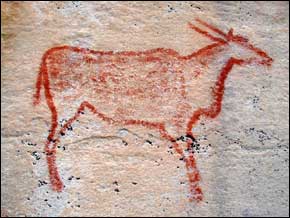
Certain bands of Bushmen in the southern Kalahari harvest a dryland species of succulent that outside of Botswana has become synonymous these days with spam. This new, clinically proven wonder drug, derived through a multinational pharmaceutical company, has become a lucrative consumer good by promising an increasingly fat affluent world that it would help buyers “lose weight…and keep it off.” Qoroxloo didn’t have an obesity problem. But Hoodia gordonii mimics the effect that glucose triggers on nerve cells; its chemicals trick the brain into thinking and feeling like they are sated, thus curbing appetites. How strangely appropriate that this quintessentially First World drug first had been discovered, tested, tried and ‘marketed’ in that outdoor laboratory, the Kalahari, by Bushmen who ate Hoodia before and during long hunting and gathering expeditions far from base camp, not knowing when they might next find a reliable access to water, in order to suppress their thirst.
Qoroxloo’s metabolism was physically on par with any one of us, but her behavior and adaptations were superior. Passive resistance and apparent inactivity are often mistaken for sloth or surrender. But Aboriginal people in arid Australia, Africa, and America were about as ‘lazy’ as a snake or lion. They habitually reduced energy expenditure in a deliberate way, to conserve precious water for only essential demands. The ability to do nothing should never be underestimated; most humans grew restless and agitated in the heat. Inside the Kalahari Reserve, Qoroxloo’s calculated restraint revealed the oldest, highly energy efficient, and, from an evolutionary standpoint, most effective form living within the rule of water.
Water discipline slowed and minimized water loss, and would help individuals adapt to dry heat, whether they were under siege in the Kalahari like Qoroxloo, or deployed to Iraq in the summer, or caught in Las Vegas or Phoenix during a power failure that disrupted air conditioning and water pumps. But discipline alone couldn’t entirely stop dehydration. Like all species, humans eventually have to replenish supplies of moisture, electrolytes and nutrients, and that required organizing activity in a highly efficient manner.
By late afternoon after the convoy departed, the hungry and thirsty Bushmen gazed out at the Kalahari they knew well. Working together, Bushmen shared what memories, information, and experience they could to recall what available food and water they could forage. After consulting the elders, the remaining females made plans and discussed where next to forage in the cool hours of the following morning as the men sharpened their knives and spears.
The government had left them to provide entirely for themselves. So be it. Since the water deliveries will no longer come to us, we will use old and new tactics to seek it in the places where only we know it resides.
Alfred Lord Tennyson, “In Memorium A.H.H.,” Canto 56.
Robert Wright, Nonzero.
Flint, R.F Glacial Quarternary Geology. New York: John Wiley & Sons,1971 p. 457, cited in Main, Kalahari: Life’s Variety in Dune & Delta, pp 7-19.
Stephanie Hancock, “Climate Change, Human Pressure shrink Lake Chad,” Reuters, Feb 2, 2007; United States Geological Survey and NASA: Landsat Project. Lake Chad, Africa Accessed Online 22 February 2008.
Main, Kalahari Dune and Delta, p. 18.
Silberbauer, Hunter and Habitat, page 96.
Gideon Louw and Mary Seely, Ecology of Desert Organisms.
Barry Lovegrove, The Living Deserts of Southern Africa, 1993.
Main, Kalahari Dune and Delta, pp. 145-149.
Veronica Roodt, Trees & Shrubs and Common Wildflowers, 1998.
Mary Seely, Tenebriod Beetles in African Insect Life.
Hanks, “The Kalahari Desert,” in Wilderness, pp. 385-392.
Richard Despard Estes, The Behavior Guide to African Mammals, 1991; J. du P. Bothma, (Ed.). Game Ranch Management, 1989.
Silberbauer, Hunter and Habitat
Silberbauer, Hunter and Habitat; Polly Weissner, Hitchcock,
Ginger Thompson, “Bushmen Share Herbal Secret with Drugmaker for a Profit.” New York Times, April 11, 2003.


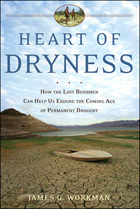



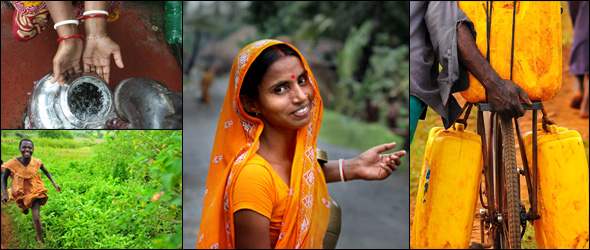


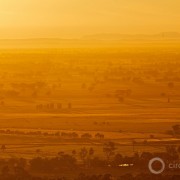


Beautiful, eloquent, as meaningful in words as Qoroxloo’s movements are sparse in meaningless movements.
If only our ‘advanced’ Western civilizations had managed to preserve some of the more adaptive strategies rather than force our environment to adapt to us.
no comment bt thats promising